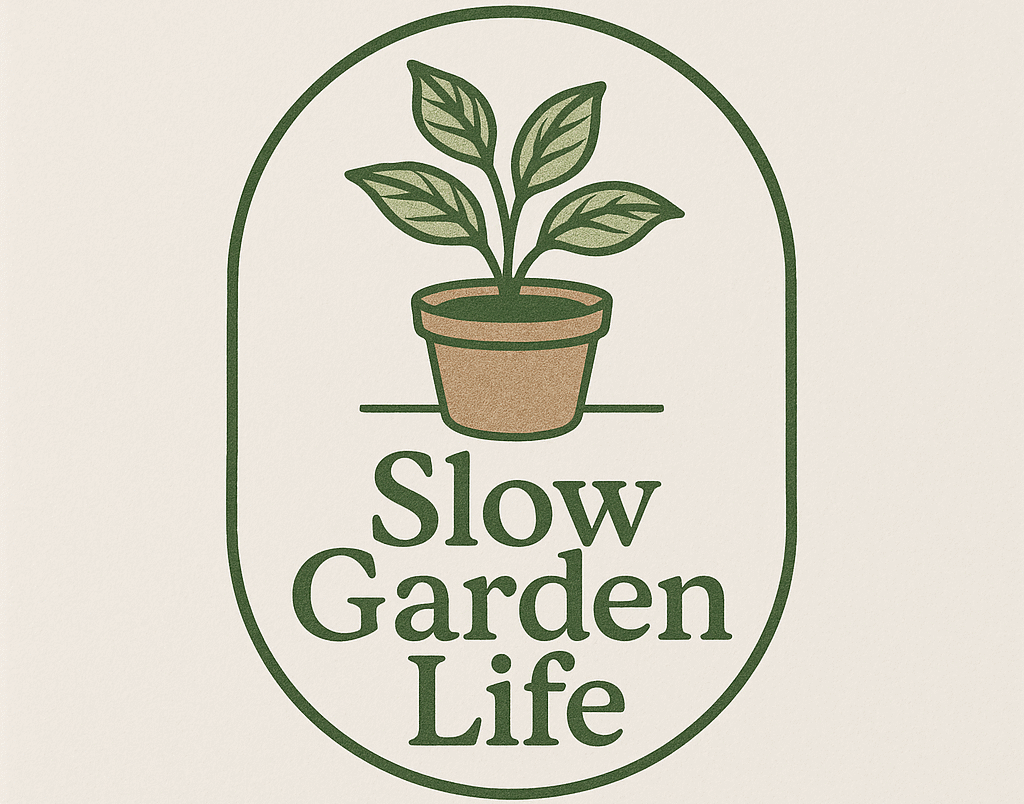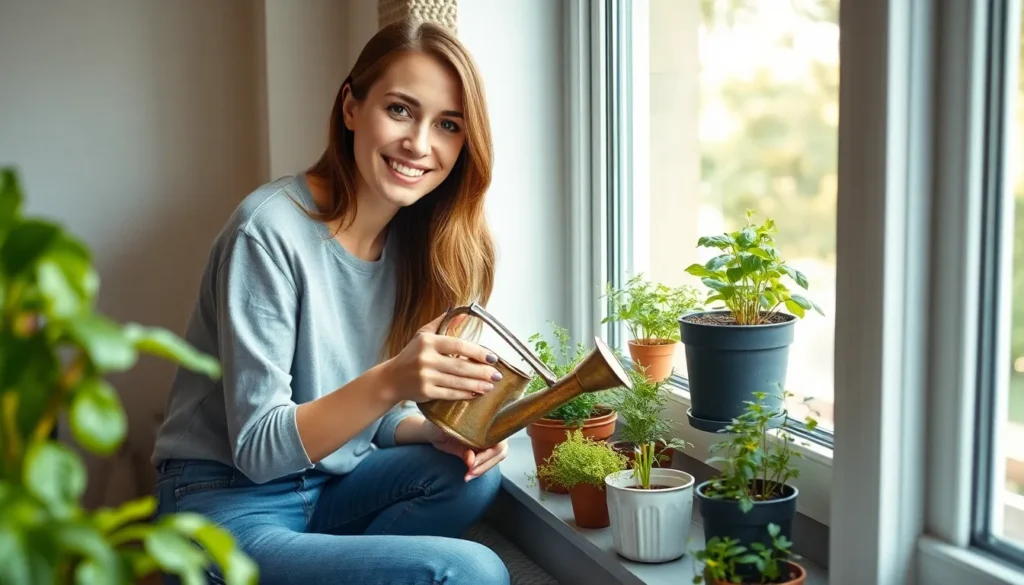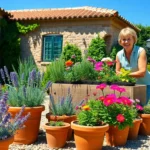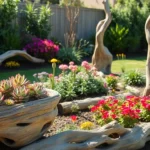Fresh herbs on your windowsill. Vibrant houseplants purifying your air. The satisfaction of growing your own food year-round. Indoor gardening transforms any living space into a thriving green oasis – and it’s easier than you think.
We’ve all dreamed of having a green thumb but felt intimidated by outdoor gardening’s unpredictable weather and complex soil requirements. Indoor gardening eliminates these barriers while offering complete control over your plant’s environment. Whether you’re living in a tiny apartment or simply want to extend your growing season we’ll show you how to create your own indoor paradise.
You don’t need expensive equipment or years of experience to get started. With just a few basic supplies and our proven beginner strategies you’ll be harvesting fresh produce and enjoying beautiful plants within weeks. Let’s jump into the simple steps that’ll turn you into a confident indoor gardener.
Choose the Right Location for Your Indoor Garden
The success of your indoor garden depends heavily on selecting the perfect spot in your home. We’ll guide you through the essential factors that determine whether your plants will thrive or struggle.
Assess Natural Light Availability
South-facing windows provide the most intense sunlight throughout the day, making them ideal for sun-loving plants like tomatoes, peppers, and herbs. These locations receive 6-8 hours of direct sunlight, which matches the needs of most vegetables and flowering plants.
East-facing windows offer gentle morning light that works well for leafy greens such as lettuce, spinach, and kale. The moderate intensity prevents leaf burn while providing enough energy for photosynthesis.
West-facing windows deliver strong afternoon sun that can be too harsh for delicate plants but perfect for succulents like aloe vera, jade plants, and echeveria. This exposure typically provides 4-6 hours of bright light.
North-facing windows receive the least direct sunlight but still support low-light plants including pothos, snake plants, and ZZ plants. These spots work best when supplemented with grow lights for optimal plant growth.
Consider Temperature and Humidity Levels
Most indoor plants thrive in temperatures between 65-75°F during the day and can tolerate slight drops to 60-65°F at night. Avoid placing your garden near heating vents, air conditioning units, or drafty windows that create temperature fluctuations.
Humidity levels between 40-60% support healthy plant growth for most indoor varieties. Kitchens and bathrooms naturally provide higher humidity, making them excellent choices for tropical plants like ferns, orchids, and air plants.
Dry winter air from heating systems often drops humidity below 30%, which can stress your plants and cause brown leaf tips. We recommend using a humidifier or placing water trays near your plants to maintain adequate moisture levels.
Monitor temperature consistency using a digital thermometer placed near your garden area. Sudden temperature changes above 10°F can shock plants and slow their growth significantly.
Evaluate Space Constraints and Layout
Vertical growing maximizes limited floor space through wall-mounted shelves, hanging planters, and tower gardens. These answers work particularly well in apartments and small homes where horizontal space is premium.
Corner locations often provide stable conditions away from foot traffic while utilizing otherwise unused areas. We’ve found that plant stands and corner shelving units create attractive displays without crowding living spaces.
Tabletop gardens suit beginners with minimal space and allow easy monitoring of plant health. Kitchen counters, dining tables, and desk surfaces accommodate small herb gardens and microgreens perfectly.
Closet conversions with grow lights create dedicated growing environments when natural light is insufficient. This approach gives you complete control over lighting schedules and eliminates weather dependency entirely.
Select Beginner-Friendly Plants for Indoor Gardening Success
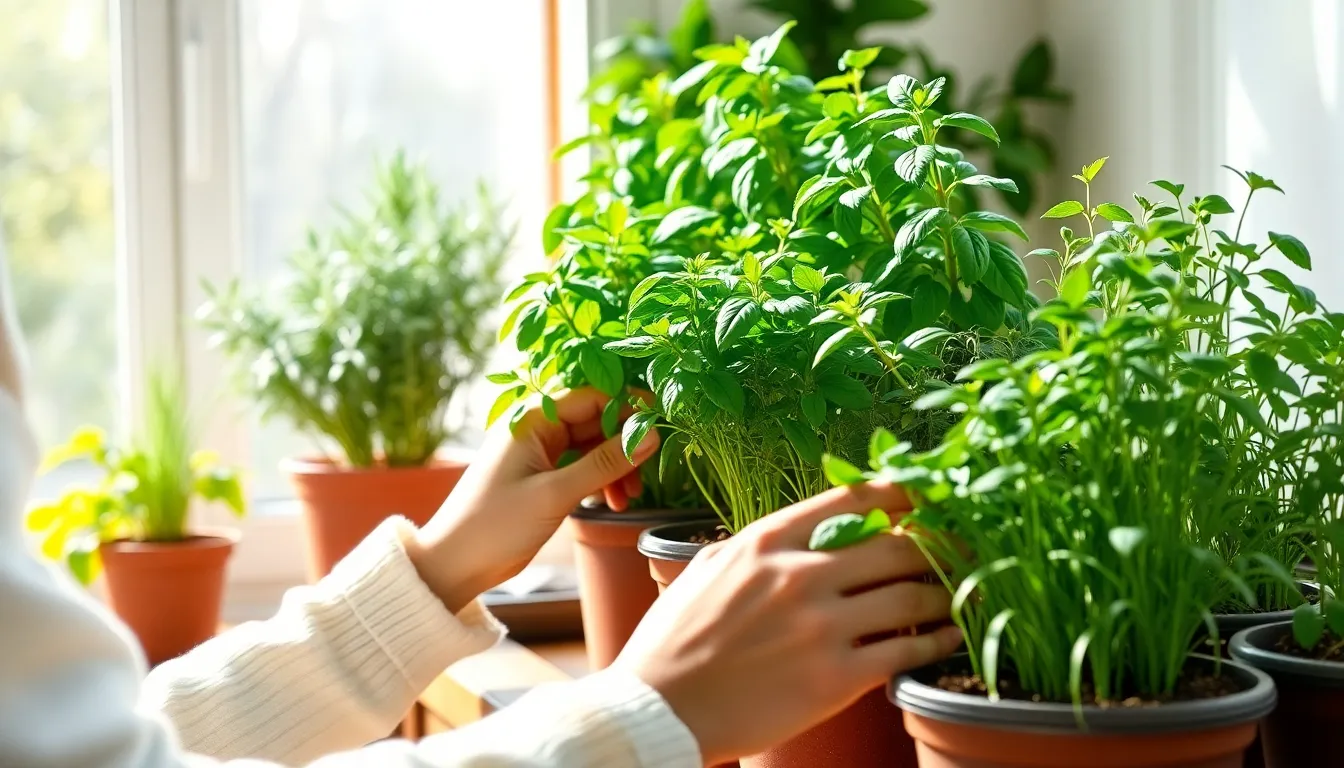
Now that you’ve found the perfect spot for your indoor garden, we’ll help you choose plants that practically guarantee success. Starting with forgiving varieties builds confidence and prevents the frustration that causes many beginners to give up.
Start with Low-Maintenance Herbs
Basil transforms your kitchen window into a culinary goldmine. This aromatic herb thrives in warm indoor conditions and provides fresh leaves for pasta dishes, pizza toppings, and homemade pesto. We recommend starting with sweet basil varieties since they’re most tolerant of indoor growing mistakes.
Mint spreads rapidly and tolerates partial shade beautifully. You’ll harvest fresh leaves for teas, cocktails, and Middle Eastern dishes within weeks of planting. Container growing actually works in your favor here since mint can become invasive outdoors.
Chives require minimal attention and bounce back from harvesting mistakes. These onion-flavored greens grow in clumps that you can snip repeatedly without harming the plant. We’ve found they’re nearly impossible to kill and produce continuously throughout the growing season.
Try Hardy Houseplants That Forgive Mistakes
Snake plants survive weeks of neglect and low light conditions. These architectural beauties with thick, upright leaves can handle forgotten watering schedules and dimly lit corners. We often recommend Sansevieria species to beginners because they actually prefer being slightly ignored.
ZZ plants bounce back from almost any care mistake you can make. Their glossy leaves and sturdy stems tolerate low light, infrequent watering, and temperature fluctuations that would stress other houseplants. You’ll see new growth even after months of minimal attention.
Spider plants produce baby plants that make propagation effortless. These cheerful green and white striped plants dangle their offspring from long stems, creating natural starter plants for friends and family. We love how they signal their needs clearly—droopy leaves mean more water, brown tips indicate too much fertilizer.
Peace lilies communicate their watering needs through dramatic drooping. Once you learn to read their signals, these elegant plants reward you with stunning white blooms and air-purifying benefits. They’ll perk up within hours of receiving water, making care timing obvious.
Consider Fast-Growing Vegetables for Quick Results
Radishes mature in just 25-30 days and require minimal space. These spicy roots grow well in shallow containers and don’t need full sun to produce crisp, colorful bulbs. We suggest trying cherry belle or French breakfast varieties for the fastest results.
Lettuce provides continuous harvests through cut-and-come-again growing. You can snip outer leaves while the center keeps producing, giving you fresh salads for weeks from a single planting. Buttercrunch and romaine varieties adapt particularly well to indoor container growing.
Cherry tomatoes produce fruit in 60-80 days and thrive in large containers. Mini varieties like ‘Tiny Tim’ and ‘Red Robin’ stay compact while producing dozens of sweet tomatoes. We recommend starting with determinate varieties since they stop growing at a manageable size and produce fruit all at once.
Gather Essential Indoor Gardening Supplies and Tools
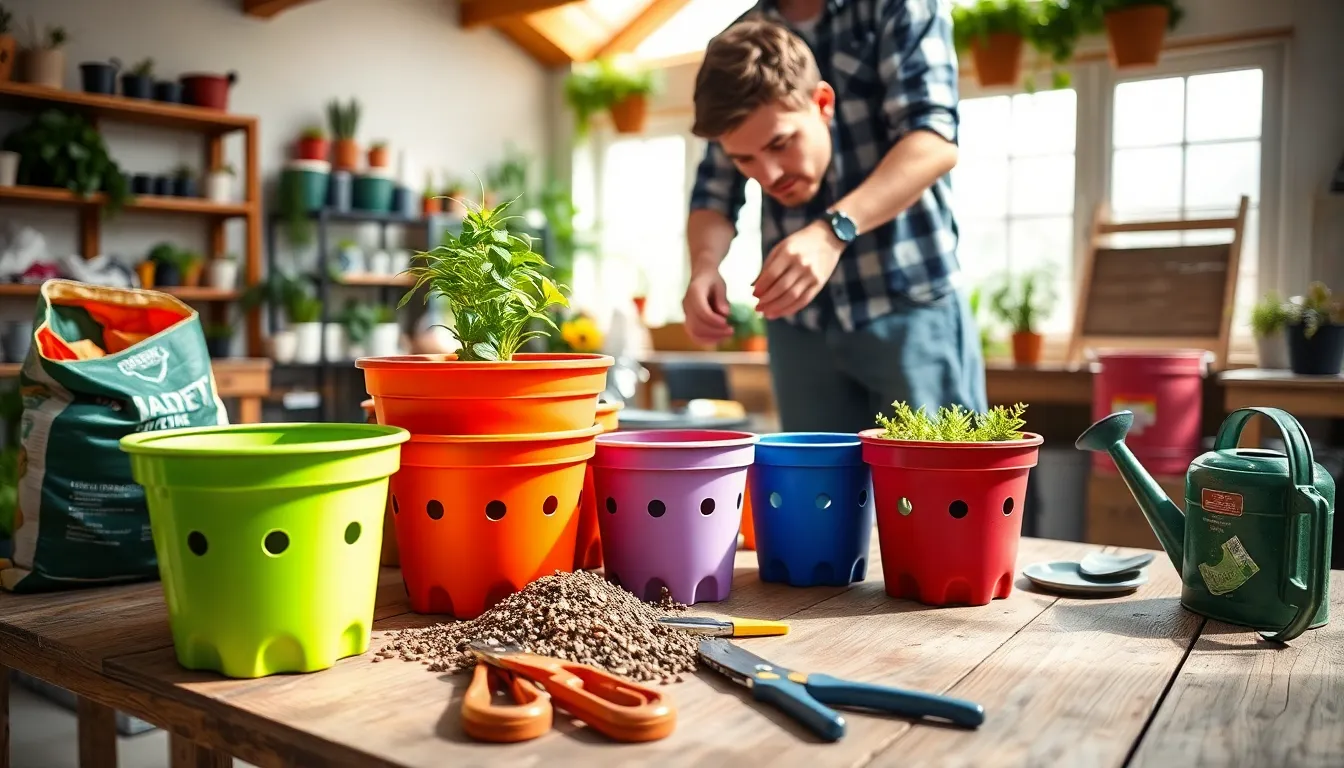
Building your indoor garden starts with acquiring the right supplies and tools. We’ll focus on three crucial categories that form the foundation of successful indoor gardening.
Invest in Quality Containers with Proper Drainage
Planters and pots with adequate drainage holes prevent waterlogged soil that can kill your plants. Good drainage allows excess water to escape, protecting roots from rot and maintaining healthy growing conditions.
Plant saucers underneath your containers protect furniture and floors from moisture damage. These practical accessories catch draining water while maintaining the professional appearance of your indoor garden setup.
Galvanized buckets or plastic bins serve dual purposes as both planters and storage answers for organizing your gardening tools. The versatility of these containers makes them valuable investments for beginner gardeners working with limited space.
Choose the Right Potting Mix for Indoor Plants
Potting mix formulated for indoor plants provides the perfect balance of moisture retention and drainage. Standard garden soil becomes too heavy and compact in containers, while specialized indoor mixes promote healthy root development.
Moisture retaining yet well draining mixes prevent both drought stress and root rot by maintaining consistent soil conditions. These professionally blended soils contain ingredients like perlite and vermiculite that create optimal growing environments for container plants.
pH balanced potting mixes eliminate guesswork for beginners by providing neutral growing conditions suitable for most indoor plants. Quality mixes also include slow release fertilizers that feed your plants for several months after planting.
Select Basic Gardening Tools for Maintenance
Hand forks break up compacted soil in containers and help with transplanting seedlings. This essential tool fits easily in small pots and allows precise soil cultivation without damaging delicate root systems.
Pruning shears or scissors keep your plants healthy by removing dead leaves, spent flowers, and overgrown branches. Regular pruning encourages bushier growth and prevents pest problems that thrive on decaying plant material.
Watering cans with long spouts deliver water precisely to soil surfaces without splashing leaves or furniture. The extended reach helps you water plants on shelves or in hanging baskets while maintaining accuracy.
Spray bottles create humid microclimates for tropical plants that require higher moisture levels. Misting tools also help clean dust from leaves, improving photosynthesis and plant appearance.
Soil testers monitor moisture, pH, and temperature levels to prevent common growing mistakes. These digital tools remove guesswork from plant care by providing accurate readings of soil conditions.
Master Proper Watering Techniques for Indoor Plants
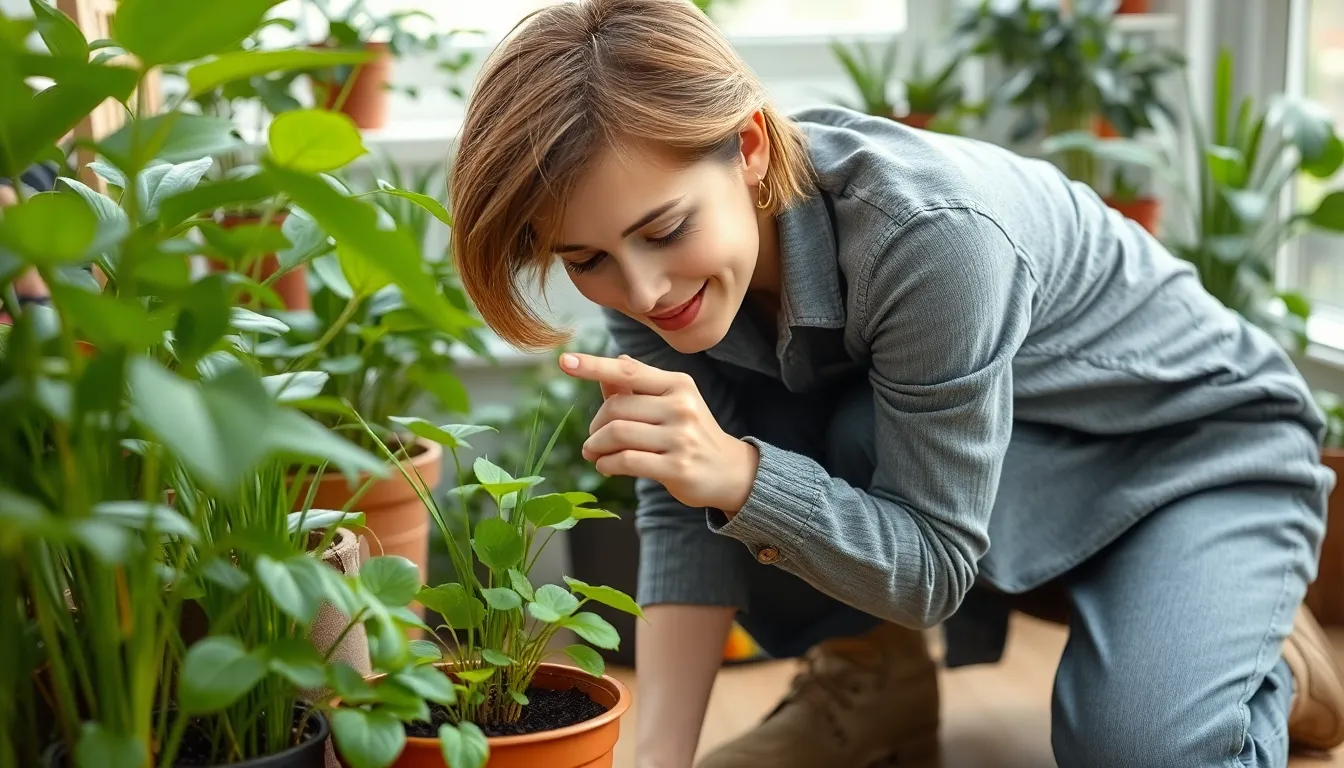
Watering indoor plants correctly forms the foundation of successful indoor gardening. We’ll explore essential techniques that ensure your plants receive the right amount of water at the right time.
Learn to Check Soil Moisture Levels
Insert your finger into the soil up to the first knuckle to feel moisture levels before watering. This simple finger test reveals whether the soil still contains adequate moisture or needs water. Use a soil tester for accurate moisture measurements when you want precise readings. Digital moisture meters provide consistent results and eliminate guesswork from your watering routine.
Check different areas of the pot since moisture levels can vary within the same container. Surface soil often appears dry while deeper layers retain moisture. Monitor plants daily during growing seasons and adjust frequency based on environmental changes like heating or air conditioning.
Understand Different Watering Needs by Plant Type
Cacti and succulents require infrequent watering since they store water in their thick leaves and stems. Water these drought tolerant plants only when soil feels completely dry, typically every 2-3 weeks. Herbs and vegetables need regular watering but avoid overwatering which causes root problems. Basil, mint, and cherry tomatoes thrive with consistent moisture without waterlogged conditions.
Flowering plants should receive thorough watering after the soil feels dry to the touch. Peace lilies and flowering houseplants perform best with steady moisture levels. Snake plants and ZZ plants tolerate neglect and prefer dry conditions between waterings. These hardy houseplants can survive weeks without water, making them perfect for busy beginners.
Avoid Common Overwatering and Underwatering Mistakes
Overwatering leads to root rot and fungal diseases that can kill your indoor plants quickly. Watch for yellowing leaves, soft stems, and musty odors that indicate too much water. Underwatering results in dry, brittle leaves with brown edges and wilting appearance. Plants suffering from water stress often drop leaves or show stunted growth.
Balance your watering schedule by observing plant responses and adjusting accordingly. Environmental factors like humidity, temperature, and season affect water needs significantly. Water in the morning so plants can absorb moisture throughout the day and reduce disease risks. Direct water to the soil rather than leaves to prevent fungal problems and ensure roots receive adequate hydration.
Provide Adequate Lighting for Healthy Plant Growth
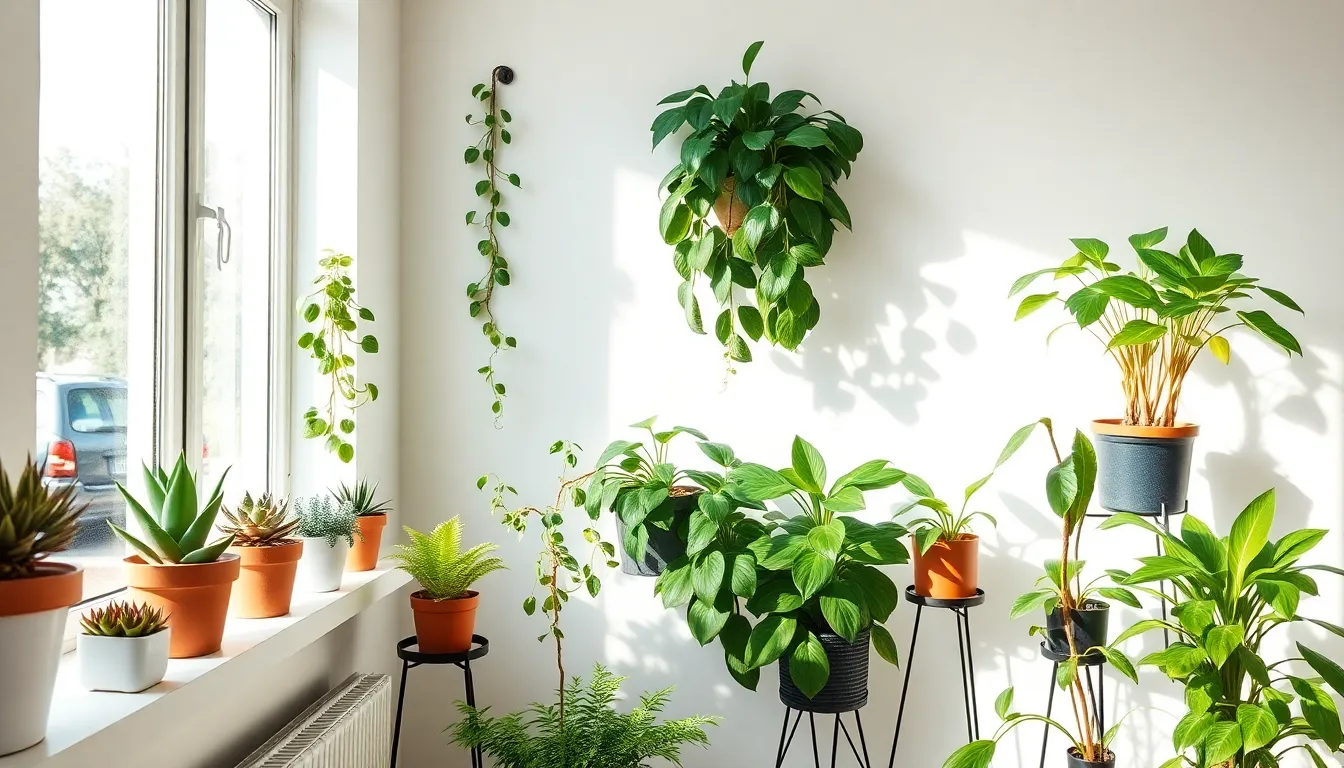
Light serves as the primary energy source for photosynthesis, making it the most critical factor for successful indoor gardening. Without adequate lighting, our plants become leggy and weak, producing fewer blooms and fruits regardless of how well we water or fertilize them.
Maximize Natural Light Sources
South facing windows deliver the brightest and most consistent sunlight throughout the day, making them perfect for sun loving plants like succulents and flowering vines. We can position our high light plants directly on these windowsills or use plant stands to maximize their exposure to this premium natural light.
East and west facing windows provide moderate light levels that work well for most houseplants and herbs. These locations receive gentler morning or afternoon sun without the intense midday heat that might stress sensitive plants.
North facing windows offer the lowest light conditions, which suit foliage plants and low light varieties perfectly. We should reserve these spots for snake plants, ZZ plants, and other shade tolerant species that thrive in dimmer environments.
Windowsills, shelves, and adjustable plant stands help us position our plants as close to natural light sources as possible. Moving plants just a few feet away from windows can significantly reduce the light they receive, so proximity matters more than we might expect.
Supplement with Artificial Grow Lights When Needed
Artificial grow lights become essential when our natural light sources can’t meet our plants’ energy requirements. LED grow lights offer the most energy efficient solution, providing customizable light spectrums that support different growth stages from seedling to flowering.
Full spectrum LED lights work best for most indoor gardens because they provide the complete range of wavelengths plants need for healthy development. We can adjust the intensity and duration based on our exact plant varieties and their changing needs throughout the seasons.
Fluorescent tubes serve as an affordable option for seedlings and low light plants, though they’re less energy efficient than LEDs. These lights work particularly well for starting herbs and leafy greens in smaller spaces.
Position grow lights 12 to 24 inches above plant canopies, adjusting the distance based on light intensity and plant response. We should run most grow lights for 12 to 16 hours daily to simulate adequate daylight exposure for optimal growth.
Position Plants According to Light Requirements
Grouping plants with similar light needs simplifies our care routine and ensures each variety receives appropriate illumination. High light plants belong near our brightest windows, while low light species thrive in dimmer corners and interior spaces.
Rotating plants weekly prevents them from leaning toward light sources and promotes balanced, symmetrical growth. This simple practice helps our plants develop strong, upright stems and prevents the lopsided appearance common in stationary indoor plants.
Plant stands and adjustable shelving systems maximize our vertical growing space while optimizing light exposure for multiple plants. We can create tiered arrangements that give each plant access to adequate lighting without casting shadows on lower levels.
Monitor our plants regularly for signs of inadequate or excessive light exposure. Yellowing leaves, stretched stems, and poor flowering indicate insufficient light, while brown leaf edges and wilting suggest too much direct sun exposure.
Create an Effective Fertilizing Schedule
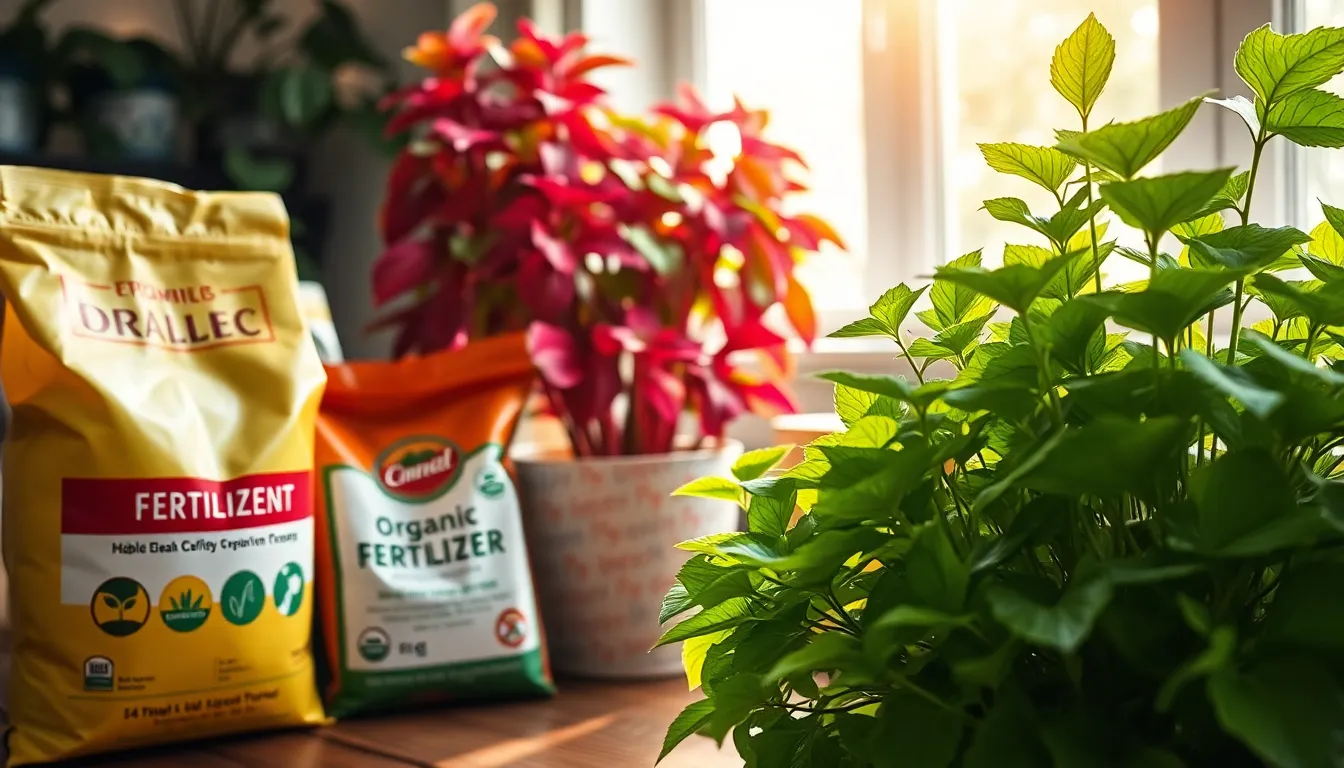
Proper fertilization schedules ensure our indoor plants receive the nutrients they need throughout different seasons.
Understand Basic Plant Nutrition Needs
Our indoor plants require three essential nutrients to thrive and grow successfully. Nitrogen promotes healthy leaf growth and keeps foliage vibrant green, making it crucial for plants like basil, lettuce, and spider plants. Phosphorus supports strong root development and encourages flowering in plants such as peace lilies and flowering herbs. Potassium aids in overall plant health by strengthening stems and improving disease resistance across all plant varieties.
These primary nutrients work together to maintain plant vitality, and deficiencies in any one can lead to stunted growth or poor plant performance. Understanding these basic nutritional requirements helps us make informed decisions about fertilizer selection and application timing.
Choose Appropriate Fertilizers for Indoor Plants
Balanced fertilizers containing equal amounts of nitrogen, phosphorus, and potassium work well for most indoor gardening situations. These fertilizers typically display ratios like 20-20-20 on their packaging and provide comprehensive nutrition for herbs, houseplants, and vegetables.
Specialized fertilizers target exact plant needs and growing phases more effectively than balanced options. High phosphorus fertilizers benefit flowering plants like peace lilies, while nitrogen rich formulas support leafy greens such as lettuce and herbs.
Organic fertilizers release nutrients slowly and naturally over extended periods, providing steady nutrition without risk of burning plant roots. Synthetic fertilizers deliver immediate nutrients but require more careful application to prevent over-fertilization damage.
Water soluble fertilizers dissolve easily and allow for precise nutrient control, while granular options provide longer lasting nutrition when applied to soil surfaces.
Discern Proper Fertilizing Frequency and Application
Spring and summer months require monthly fertilization as plants experience active growth periods and higher nutrient demands. During these seasons, our indoor gardens benefit from consistent feeding schedules that support vigorous development.
Fall and winter seasons need reduced fertilizing frequency of every 2-3 months since plant growth naturally slows during dormant periods. Lower light levels and cooler temperatures decrease nutrient requirements significantly.
Following package instructions prevents over-fertilization which can damage roots and cause nutrient burn in sensitive plants. We should always dilute fertilizers according to manufacturer recommendations and err on the side of under-feeding rather than over-feeding.
Monitoring plant health guides schedule adjustments based on individual plant responses and environmental conditions. Signs of nutrient deficiency include yellowing leaves, stunted growth, or poor flowering, while over-fertilization symptoms include brown leaf tips and excessive green growth without flowering.
Monitor and Maintain Proper Air Circulation
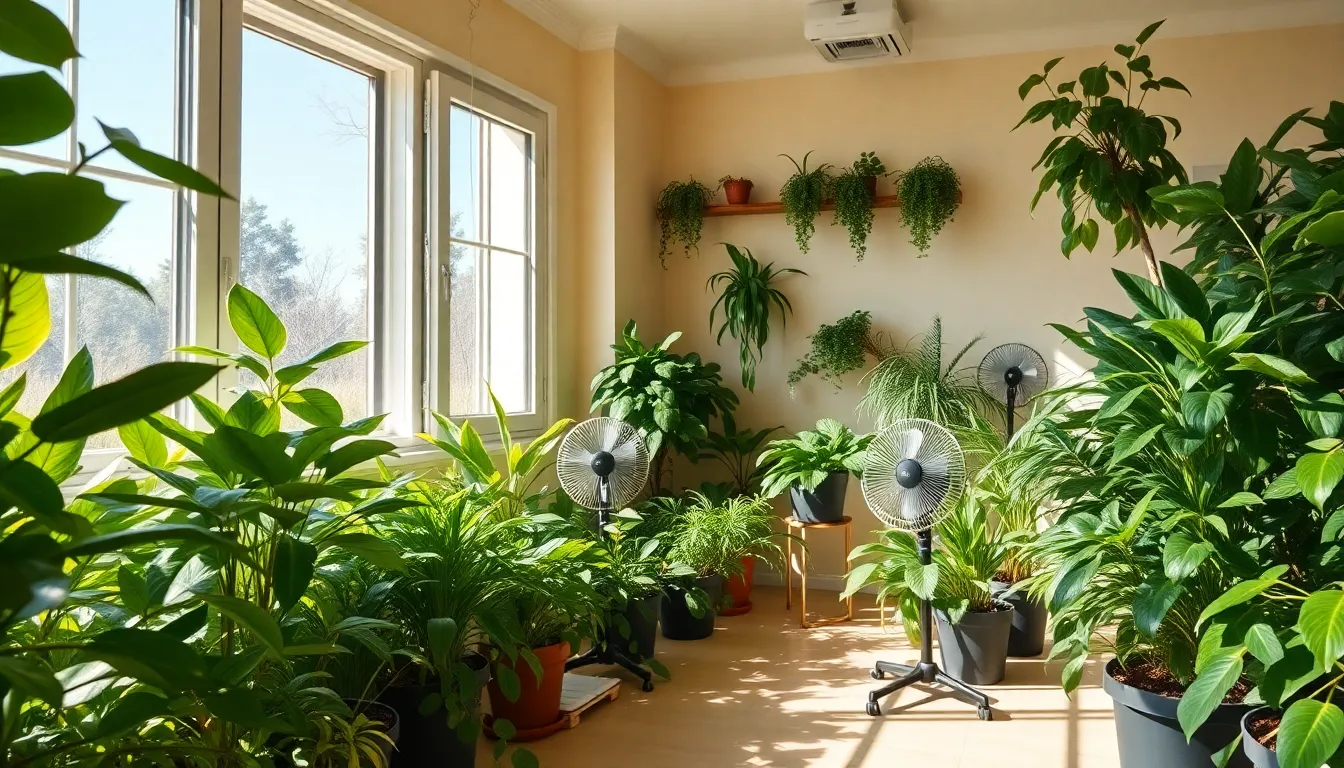
Fresh air circulation keeps our indoor plants healthy and prevents common growing problems. Proper ventilation creates the ideal environment for plant growth while protecting against moisture-related issues.
Ensure Good Ventilation Around Plants
Position plants with adequate spacing to allow air to flow freely between them. Crowded plants create humid microclimates that encourage fungal diseases and bacterial infections to develop rapidly.
Place plants away from heat sources like radiators, vents, and electronics that can create hot spots and disrupt natural air movement. We recommend maintaining at least 6 inches of space between plants and heating elements to prevent damage.
Open windows regularly when outdoor temperatures remain between 65°F and 75°F to introduce fresh air into our growing spaces. Natural ventilation helps regulate humidity levels and brings in carbon dioxide that plants need for photosynthesis.
Create cross ventilation by opening windows or doors on opposite sides of the room when possible. This technique establishes gentle air currents that benefit plant health without creating harsh drafts.
Use Fans to Improve Air Movement
Install small desk fans or clip-on fans near our plant displays to create consistent air circulation. We set fans on low speed to generate gentle movement rather than strong winds that can stress or damage delicate foliage.
Position fans to blow air across plant canopies rather than directly at individual plants. Indirect airflow prevents leaf damage while still providing the circulation benefits that promote healthy growth.
Run fans for 4-6 hours daily during peak growing seasons when plants are most active. Consistent air movement helps strengthen plant stems and reduces the risk of pest infestations that thrive in still air.
Use oscillating fans to distribute air evenly throughout larger growing areas. These fans prevent concentrated airflow in one direction while ensuring all plants receive adequate ventilation.
Prevent Stagnant Air That Leads to Plant Problems
Monitor for signs of poor air circulation including yellowing leaves, musty odors, or white fuzzy growth on soil surfaces. These symptoms often indicate moisture buildup caused by inadequate ventilation.
Rotate plants weekly to ensure all sides receive equal air exposure and prevent moisture from accumulating on one side. Regular rotation also promotes balanced growth and prevents plants from leaning toward light sources.
Remove dead leaves and debris promptly from plant containers and surrounding areas. Decaying organic matter creates breeding grounds for harmful bacteria and fungi that thrive in stagnant conditions.
Space plants according to their mature size rather than their current dimensions to prevent overcrowding as they grow. Proper spacing maintains good airflow and reduces competition for light and nutrients between neighboring plants.
Recognize and Address Common Indoor Gardening Problems
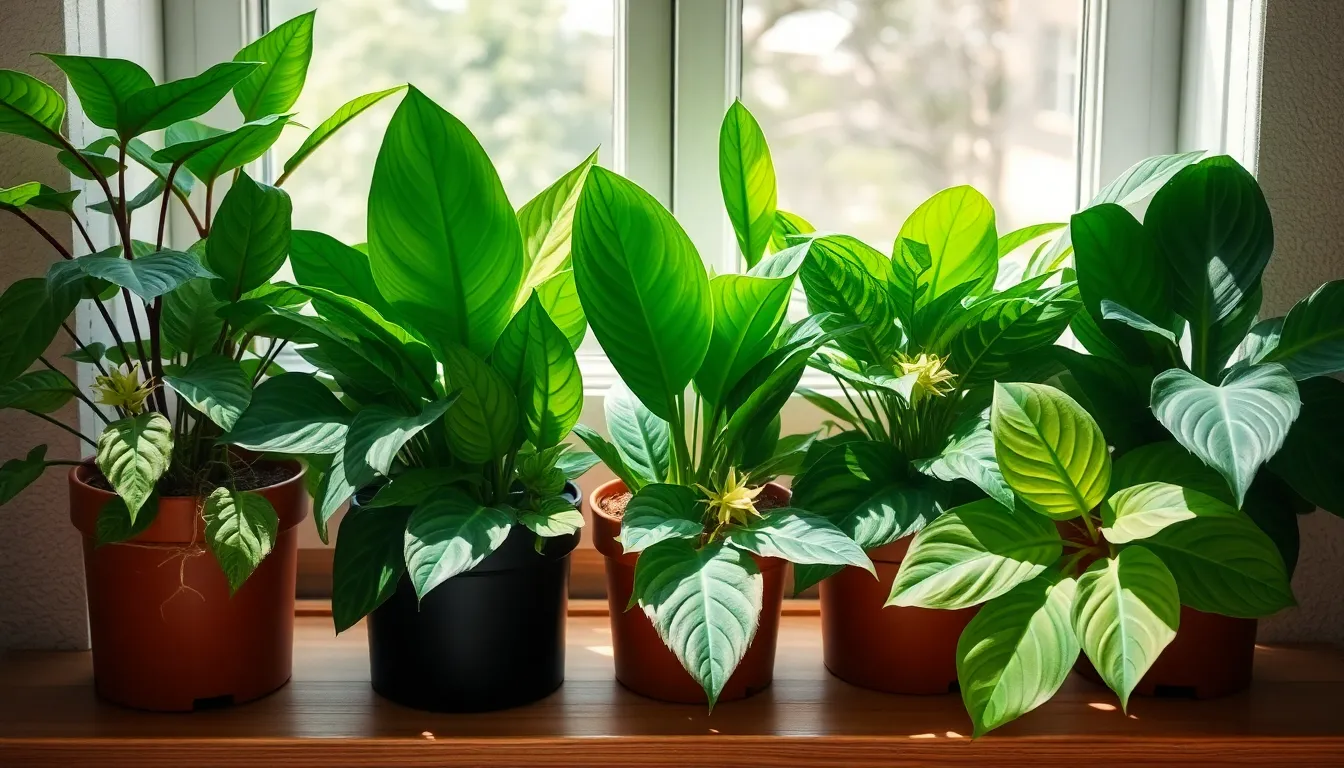
Even the most careful indoor gardeners encounter challenges that can affect plant health. Quick identification and proper response to these issues will help maintain your thriving indoor garden.
Identify Signs of Pests and Diseases
Spider mites appear as tiny moving dots on leaf undersides and create fine webbing between stems and leaves. We can spot these microscopic pests by holding a white paper under affected leaves and gently tapping them to see small specks fall onto the paper.
Mealybugs look like small white cotton balls clustered in leaf joints and stem crevices. These soft-bodied insects leave behind sticky honeydew that attracts ants and promotes black sooty mold growth.
Aphids gather in large colonies on new growth and flower buds, appearing as tiny green, black, or white insects. They cause leaves to curl and yellow while secreting the same sticky substance that mealybugs produce.
Fungal diseases manifest as white powdery patches on leaf surfaces or dark circular spots with yellow halos. These conditions thrive in high humidity environments with poor air circulation.
Bacterial diseases create soft, water-soaked spots that may ooze liquid and emit foul odors. Plants infected with bacterial issues often show rapid decline in affected areas.
Troubleshoot Yellowing or Dropping Leaves
Overwatering causes lower leaves to turn yellow and feel mushy to the touch. The soil remains consistently wet, and you might notice a musty smell from the potting mix indicating root rot development.
Nutrient deficiency leads to uniform yellowing across older leaves first, while new growth remains green. Plants lacking nitrogen show this pattern most commonly in indoor growing conditions.
Excessive direct sunlight burns leaf edges and creates brown, crispy patches before entire leaves turn yellow. Moving plants away from intense afternoon sun typically resolves this issue within days.
Lack of moisture triggers sudden leaf drop without yellowing, particularly affecting plants near heating vents or air conditioning units. Leaves may appear wilted before falling off completely.
Temperature fluctuations cause rapid leaf drop when plants experience sudden changes of more than 10 degrees. This stress response often occurs after moving plants or during seasonal HVAC adjustments.
Root disturbance from recent repotting or root bound conditions leads to widespread leaf drop as plants redirect energy toward root recovery. This temporary setback usually resolves within 2-3 weeks with proper care.
Adjust Care Practices Based on Plant Response
Watering adjustments should reflect both soil moisture levels and individual plant requirements. Check soil 1-2 inches deep with your finger before watering, and modify frequency based on seasonal changes and plant growth phases.
Lighting modifications become necessary when plants show signs of light stress through leggy growth or pale coloration. Position grow lights 12-18 inches above foliage for most houseplants, adjusting distance based on plant response over 1-2 weeks.
Fertilization changes depend on plant growth patterns and seasonal requirements. Reduce feeding frequency to every 6-8 weeks during fall and winter months when most indoor plants enter dormancy periods.
Pruning practices help redirect plant energy toward healthy growth by removing affected leaves and stems immediately. Clean pruning tools with rubbing alcohol between cuts to prevent spreading diseases or pests to healthy plant parts.
Environmental controls require monitoring humidity levels between 40-60% for most indoor plants using a digital hygrometer. Increase humidity through grouping plants together or using pebble trays filled with water during dry winter months.
Expand Your Indoor Garden as You Gain Experience
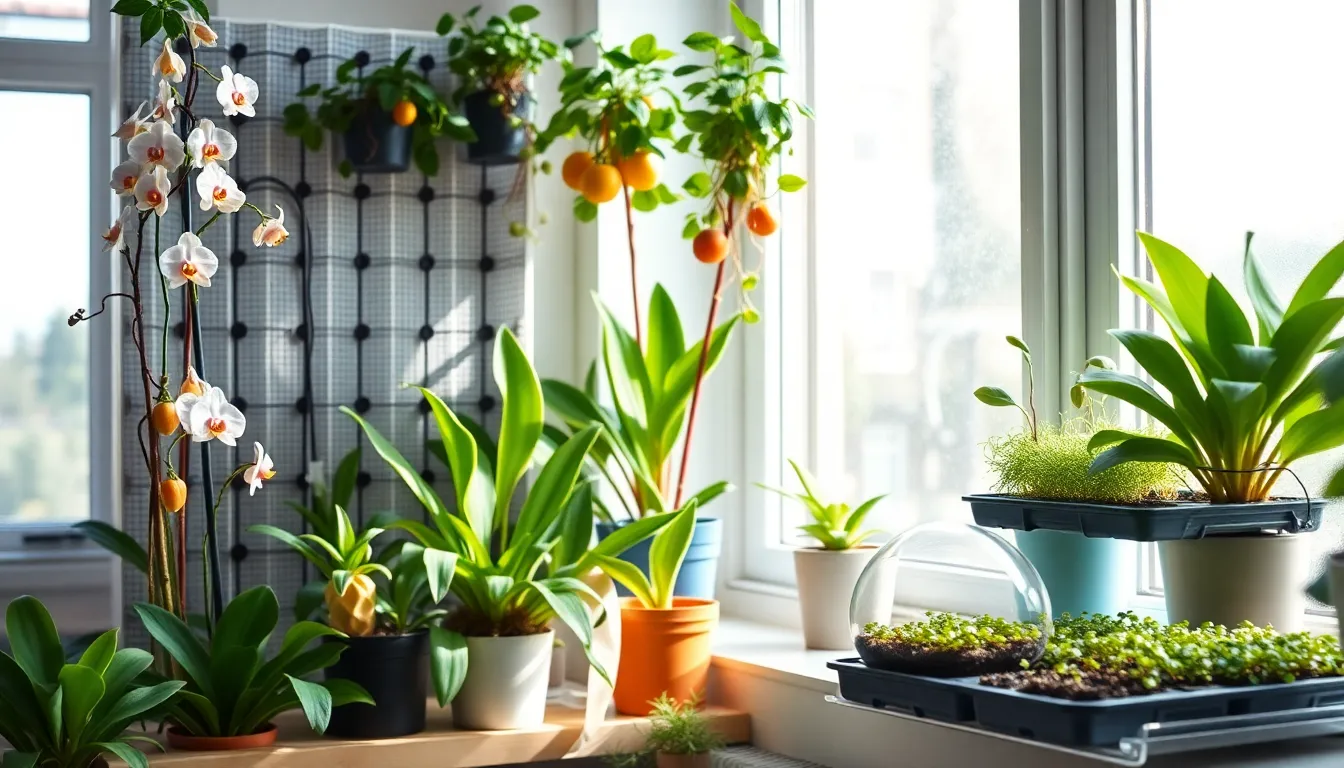
Once you’ve mastered the basics and watched your first plants thrive, it’s time to challenge yourself with more advanced techniques and varieties. Building confidence through early successes prepares us for the exciting journey of expanding our indoor gardening horizons.
Gradually Add More Challenging Plant Varieties
Orchids offer stunning blooms but require exact humidity levels and careful watering schedules that differ from our starter plants. These elegant flowers need bright, indirect light and specialized orchid potting mix to flourish indoors.
Citrus trees like dwarf lemons or limes bring both beauty and functionality to our homes while demanding consistent temperatures between 65-70°F. Meyer lemon trees, Key lime trees, and calamondin oranges adapt well to container growing when we provide adequate drainage and regular feeding.
Carnivorous plants such as Venus flytraps and pitcher plants fascinate with their unique feeding mechanisms but need distilled water and high humidity environments. These specialized varieties require dormancy periods and exact soil conditions that challenge our growing skills.
Microgreens including arugula, radish, and pea shoots provide quick harvests in just 7-14 days while teaching us precision timing and harvesting techniques. We can grow these nutrient dense greens year round using shallow trays and regular misting schedules.
Experiment with Different Growing Methods
Hydroponics eliminates soil completely and allows us to grow plants in nutrient rich water answers for faster growth rates. Deep water culture systems, nutrient film technique setups, and ebb and flow systems each offer different advantages for various plant types.
Terrariums create miniature ecosystems in glass containers that require minimal maintenance once established properly. Closed terrariums maintain their own water cycle through condensation while open terrariums provide better air circulation for plants like succulents and air plants.
Aquaponics combines fish keeping with plant growing as fish waste provides natural fertilizer for our vegetables and herbs. This sustainable method requires careful balance between fish health and plant nutrition but produces both protein and produce simultaneously.
Seed starting techniques help us grow plants from scratch using seed trays and domes for controlled germination environments. Starting herbs like basil, mint, parsley, sage, and thyme from seed costs less than buying established plants while giving us complete control over growing conditions.
Scale Up Your Indoor Gardening Setup
Vertical growing systems maximize our space by stacking plants upward using tower gardens, wall mounted planters, and tiered shelving units. These systems work particularly well for herbs, leafy greens, and strawberries that don’t require extensive root space.
Grow tent installations provide dedicated growing environments with controlled lighting, ventilation, and temperature for serious indoor gardeners. Professional grade tents allow us to grow vegetables like bush beans and patio variety cucumbers that need consistent conditions throughout their growing cycle.
Multiple growing zones let us cultivate plants with different requirements simultaneously by creating distinct areas for tropical plants, temperate vegetables, and desert succulents. We can designate sunny windowsills for sun loving plants while using grow lights for shade tolerant varieties in interior spaces.
Seasonal rotation schedules help us maintain continuous harvests by planting new crops every few weeks and utilizing succession planting techniques. Growing onions, chives, and garlic in containers allows us to harvest both greens and bulbs while maintaining productive garden cycles year round.
Conclusion
We’ve equipped you with everything needed to start your indoor gardening journey successfully. From selecting the perfect location and beginner-friendly plants to mastering watering techniques and troubleshooting common issues you now have the foundation to create a thriving indoor garden.
Remember that indoor gardening is a rewarding journey that gets easier with experience. Start small with a few herbs or hardy houseplants and gradually expand your collection as you build confidence. Your plants will teach you what they need through their responses to your care.
The most important step is simply beginning. Choose your first plant grab the essential supplies and watch as your indoor space transforms into a green sanctuary that brings joy and fresh produce to your home year-round.
Frequently Asked Questions
What are the main benefits of indoor gardening?
Indoor gardening allows complete control over your plant environment, eliminating concerns about unpredictable weather and soil complexities. It transforms living spaces into green oases and enables you to grow fresh produce and beautiful plants year-round. You don’t need expensive equipment or extensive experience to start successfully.
How do I choose the right location for my indoor garden?
Consider window orientation for natural light: south-facing windows for sun-loving plants, east-facing for leafy greens, west-facing for succulents, and north-facing for low-light varieties. Maintain appropriate temperature and humidity levels, and ensure good air circulation. Maximize space through vertical gardening, corner locations, or tabletop setups.
What are the best beginner-friendly plants for indoor gardening?
Start with low-maintenance herbs like basil, mint, and chives. Hardy houseplants such as snake plants, ZZ plants, spider plants, and peace lilies are excellent choices. For vegetables, try fast-growing options like radishes, lettuce, and cherry tomatoes that provide quick results and thrive indoors.
What essential supplies do I need for indoor gardening?
You’ll need quality containers with proper drainage, potting mixes specifically formulated for indoor plants, and basic gardening tools including hand forks, pruning shears, watering cans, and soil testers. These supplies help maintain plant health and monitor growing conditions effectively.
How often should I water my indoor plants?
Check soil moisture using the finger test or a digital moisture meter. Cacti and succulents need infrequent watering, while herbs and flowering plants require consistent moisture without overwatering. Adjust watering schedules based on plant type, season, and environmental factors like temperature and humidity.
Do indoor plants need special lighting?
Yes, adequate lighting is crucial for photosynthesis. Maximize natural light from windows and supplement with artificial grow lights when necessary. Position plants according to their light requirements, group them by similar needs, and rotate regularly for balanced growth. Monitor for signs of inadequate or excessive light exposure.
How do I create a proper fertilizing schedule?
Use balanced fertilizers containing nitrogen, phosphorus, and potassium for general needs. Fertilize monthly during spring and summer growth periods, reducing frequency in fall and winter. Follow package instructions to avoid over-fertilization, and choose between organic or synthetic options based on your preferences and plant requirements.
Why is air circulation important for indoor plants?
Good air circulation prevents moisture-related issues and promotes healthy growth. Space plants adequately, avoid placing them near heat sources, and use fans to improve airflow. Open windows when temperatures allow, and watch for signs of poor circulation like yellowing leaves or musty odors.
What common problems should I watch for in indoor gardening?
Monitor for pests like spider mites, mealybugs, and aphids, as well as fungal or bacterial infections. Watch for yellowing or dropping leaves caused by overwatering, nutrient deficiencies, excessive sunlight, or temperature fluctuations. Quick identification and response are key to maintaining plant health.
How can I expand my indoor gardening skills over time?
Gradually add challenging varieties like orchids, citrus trees, or carnivorous plants. Explore different growing methods including hydroponics, terrariums, and seed starting. Scale up with vertical systems, grow tents, and multiple growing zones. Implement seasonal rotation schedules for continuous harvests and enhanced gardening expertise.
